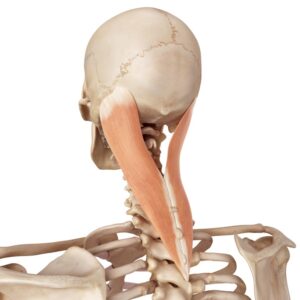Have you been trying to stretch your sternocleidomastoid (SCM) without success? Did you pull on your head intensely only to notice a stretch in the wrong place, or perhaps even felt pain in your neck?
You’ve come to the right place! Most SCM stretch instructions ignore the underlying anatomy of the muscle. Chances are, you may have turned your head in the wrong direction while attempting to stretch.
In this post, we’ll teach you how to position your head to lengthen the SCM easily so you can stretch it effectively without ripping off your head.
Table of Contents
How To Stretch Your SCM Muscle
To understand how you can stretch your sternocleidomastoid (SCM) effectively, you have to know where this muscle attaches and which head movements lengthen it.

The SCM muscle originates at your collarbone (clavicle) and breastbone (sternum) and inserts at the base of your skull, just behind your ear.
Engaging the SCM on only one side leads to the following movements (depending on which other muscles are engaged at the same time):
- When you contract your left SCM, you tilt your head to the left side — bringing your left ear to your shoulder.
- When you contract your left SCM, you turn your head to the right (opposite) side — looking over your right shoulder. A lot of stretches overlook this aspect and have you turn your head in the wrong direction, making them less effective.
This information tells you how to lengthen your SCM by simply doing the opposite: To lengthen your SCM on the left side, turn your head slightly to the left — looking over your left shoulder — and tilt it to the right side, bringing your right ear to your shoulder.
Is it not stretching yet? Move your chin up towards the sky.
Step-By-Step Instructions
Here is how you stretch your left SCM step-by-step:

- Turn your head slightly to the left (as if you were looking over your left shoulder)
- Tilt your head to the right (as if you were bringing your right ear to your shoulder)
- Tilt your head up (as if you were pointing your chin at the sky)
- Keep your left shoulder down by driving your left hand to the floor.
- If you’re not feeling the stretch in your SCM yet, play around with slight head angle shifts. For example, try rotating your head more towards the middle. This allows you to tilt your head further back and to the right.
- If you feel like you need to push your head a little deeper into the stretch, use two fingers to push and be gentle. If you stretch your left SCM, use your right hand for that. Remember that the SCM attaches to your collarbone, so it is essential to keep your shoulder down on the side you’re stretching to lengthen the muscle.
To stretch your right SCM, repeat the movements on the opposite side. You can perform the stretch standing or sitting.
Intuition Behind Stretching Your SCM
Now that you know how to stretch your sternocleidomastoid, let’s take a look at why you want to stretch it in the first place. As you’ll see, stretching alone will probably not solve your problems long-term.
Pain In The Neck, Head, Or Face and Other Symptoms
If your SCM is very tight and sensitive, the pain is not restricted to the neck. You might feel it in the throat, face, ears, eyes, or shoulders. This condition is known as Sternocleidomastoid Syndrome. It is also a common cause of tension headaches.
In severe cases, a tight SCM can lead to neck movement restrictions, dizziness, vertigo, and/or nausea.
To relieve tension in your neck, self massaging the SCM and stretching are effective methods you can try. During the stretch, your pain might intensify at first, but then get better after.
SCM Stretch for Forward Head Posture
When both SCM muscles engage at the same time while keeping your head parallel to the floor, your head is pulled forward. If you find yourself constantly in a forward head posture, stretching your SCM to relieve tension can help.
However, it is not enough to fix your text neck.
Why Stretching Is Not Enough
Whether you suffer from SCM syndrome or forward head posture, stretching is a good way to start.
In case of pain, stretching will relieve tension and hopefully decrease the intensity of the pain quickly. However, if you keep having problems with this muscle, you have to address the underlying cause of the tension: The surrounding neck muscles are not doing their job.
Therefore, strengthening your neck is necessary too. When the other neck muscles become strong enough to hold your head in position, your SCM doesn’t have to compensate anymore. The problem of constant tension will go away. However, you have to be patient. The strength gains won’t come overnight but they will come slowly over time — if you consistently train.
To assist in strengthening your neck, we have compiled a free guide covering all the neck exercises you’ll ever need. They are safe to do and we even provide you a PDF sheet summarizing all of them.
Similarly, forward head posture is not caused by the SCM alone. Muscles in your neck, shoulders, back, and the rest of your body all play a crucial role in your posture. Your SCM doesn’t pull your head forward because it is too strong or “overactive”. Other muscles are simply not performing their job well enough.
Strengthening your neck will also contribute to fixing forward head posture. But text neck is not an isolated problem. Oftentimes, your posture is disrupted from the bottom up. Therefore, focusing only on the neck will not solve the problem. To truly see change, you have to work on your whole body. Our posture improvement plan does exactly that.













